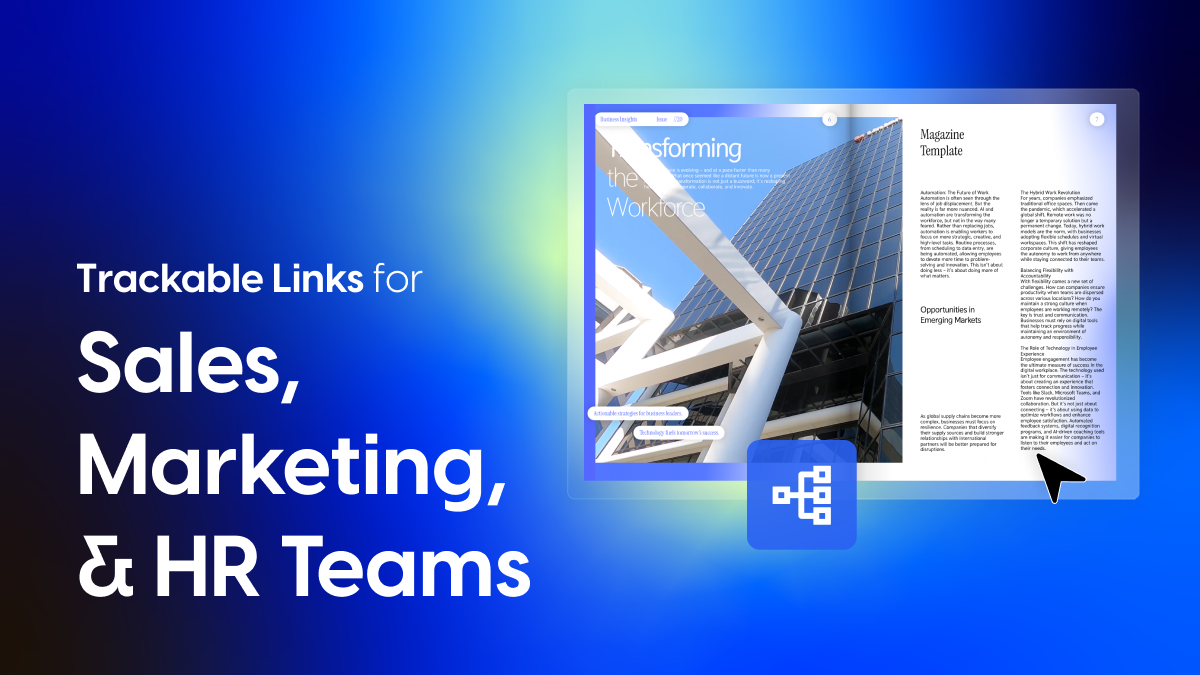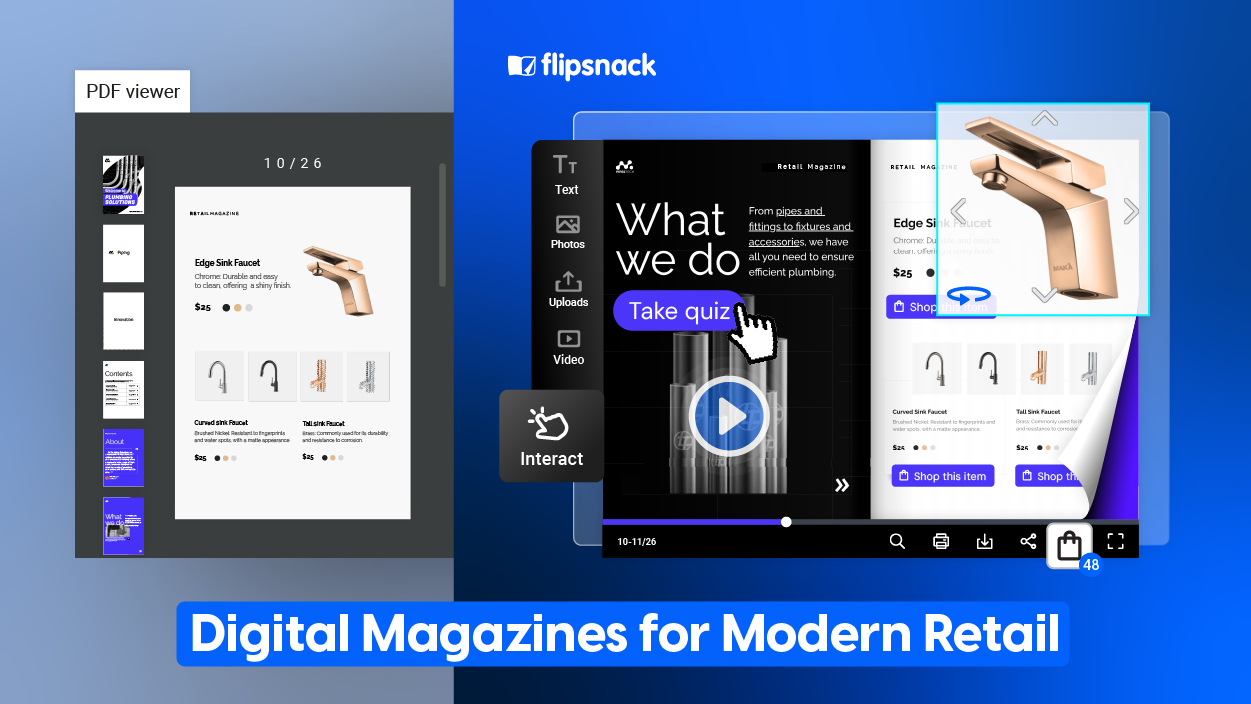Trackable Links for Sales, Marketing, and HR Teams
Every company creates content. Sales teams build proposals and pitch decks. Marketing departments publish research reports, campaigns, and glossy brochures. HR teams prepare policy handbooks and onboarding guides. Hours go into crafting these materials. Budgets are spent on design and distribution. And then, after all that effort, everyone asks the same question: did it work?
Most organizations turn to traditional analytics for the answer. If the content is shared as a static PDF or uploaded to platforms like Dropbox, Publitas, or WeTransfer, the data they get is usually limited to surface-level numbers: how many times a file was opened, how long the average reader spent on it, or whether it was downloaded. These general statistics aren’t without value. They help spot overall patterns and compare performance across campaigns.
But on their own, they rarely tell the full story. You might see that a document was opened 2,000 times. You might see that the average read time was four minutes. Those numbers look impressive in a report, but they rarely tell the full story. They do not reveal whether the decision maker you care about actually engaged with the right section. They do not tell you whether employees read a new compliance update. They do not show if a prospect skipped past the introduction and went straight to pricing.
The gap between surface-level metrics and meaningful insight is where Flipsnack’s individual trackable links come in. They give companies the ability to see not only that content was viewed, but who viewed it, when it was opened, and what parts received attention.
Instead of guessing, organizations can finally know.
Table of contents
- Traditional analytics vs individual statistics
- What are individual trackable links?
- How do trackable links improve sales strategy?
- How do marketing teams use trackable links?
- How can HR use trackable links for compliance?
- A real-world example: how Benifex uses Flipsnack
- Why notifications matter
- What is the business impact of trackable links?
- Moving beyond vanity metrics
- Final thoughts

Traditional analytics vs individual statistics
Traditional content analytics were built to provide general trends. They look at the audience as a whole and summarize behavior in numbers. That might mean reporting the total number of views, the average time spent, or the bounce rate. These measurements can be useful for spotting large patterns, but they are rarely enough for teams that need to act on the data.
Consider a sales manager reviewing performance at the end of the quarter. Their team sent out an important proposal. The analytics show that it was opened 1,200 times, the average read time was three minutes, and the bounce rate was just under 50 percent. On paper, it seems like the proposal reached a wide audience. But what can the sales manager really do with that information?
They still do not know which prospects actually read the proposal in detail. They do not know if anyone lingered on the pricing section. They cannot connect the data to specific deals in the pipeline. In other words, the analytics are broad but not actionable.
This problem repeats across departments. Marketing teams can see how many people downloaded a report, but not which sections sparked the most interest. HR can distribute a handbook, but they cannot confirm that employees actually read it. Leaders see dashboards full of numbers, but the numbers do not connect to real outcomes.
This is why companies are moving away from vanity metrics and toward individual-level analytics.
What are individual trackable links?
Flipsnack’s individual trackable links were designed to address this gap. The concept is simple but powerful. Instead of sending the same general link to everyone, teams can create unique links for each audience, channel, or person.
Each link gathers data separately. That means you can see how a proposal performs with one prospect compared to another, or how a report engages one industry segment versus another. You can also give every sales rep their own link and track both rep activity and prospect behavior.
The result is a new kind of visibility. You no longer only know that a document was opened. You know who opened it, how much time they spent, what sections mattered to them, and whether they came back to it later.
This clarity comes to life when you look at how different teams use it.

How do trackable links improve sales strategy?
Imagine you are a sales rep working with a high value prospect. You send a proposal that outlines your solution, includes case studies, and closes with pricing. In the past, you might have waited nervously, wondering whether the client opened it, whether they cared, and whether they were comparing you to a competitor.
With Flipsnack, you do not have to wonder. You created a unique trackable link just for that prospect. When you check the analytics, you see that the client skimmed the introduction, skipped the case studies, but spent seven full minutes on the pricing page.
That detail tells you everything about where to focus. Instead of repeating your standard pitch in the follow up call, you can tailor the conversation to address cost and value. You can prepare examples of similar companies that justified the investment. You can show return on investment data. You can anticipate their concerns before they even raise them.
What used to be a guessing game becomes a guided conversation. Multiply that by a full sales team, and suddenly every rep has sharper insight, better timing, and more meaningful conversations.
How do marketing teams use trackable links?
Now picture a marketing team that has just published a mid year product report. They send it to a lead list of thousands, spread across industries like healthcare and finance. Normally, they would track opens, downloads, and maybe clicks. But with trackable links, they can go deeper.
They assign one link for healthcare leads and another for finance leads. A few weeks later, they review the analytics. The healthcare audience spent significantly more time on a section about a new feature. The finance audience focused on a different part.
This insight changes their next move. Instead of sending the same follow up to everyone, they design a hyper targeted campaign. Healthcare leads get content centered on the new feature they showed interest in. Finance leads get a different set of materials. Ad budgets shift toward the segment showing stronger engagement.
The sales team also benefits. They know which prospects engaged with which sections, so their outreach can be more personal and effective.
The difference is clear. Without trackable links, the marketers would only know that thousands of people downloaded the report. With trackable links, they know what actually caught attention and can act on it.
How can HR use trackable links for compliance?
The same principle applies inside the organization. Consider an HR manager tasked with rolling out a new policy handbook to thousands of employees. In the past, they might have sent it by email, uploaded it to the intranet, and hoped employees read it.
But hope is not compliance.
By creating individual trackable links for each employee, the HR manager can confirm not only that the handbook was opened, but also that it was reviewed. They can even see which sections received the most attention. If certain pages are consistently skipped, that is a signal that the content may need to be communicated in a different way.
This accountability is critical in industries like healthcare, finance, or government, where compliance is not optional. It also gives HR leaders peace of mind. Instead of fielding questions about whether employees received and understood the policy, they have data that proves it.
A real-world example: how Benifex uses Flipsnack
Flipsnack’s customer stories highlight how this works in practice. One example is Benifex, a global benefits platform. Benifex needed a better way to share content with clients and prospects. They were producing detailed reports and resources, but traditional PDFs were limiting. It was difficult to track engagement, and production was time consuming.
By moving to Flipsnack, Benifex transformed both how they created content and how they measured its impact. They cut production time in half by using flipbooks instead of static PDFs. Their flagship “Big Benefits Report” reached more than 1,700 unique readers, with an average read time of six minutes. Over the course of a year, their personalized ABM campaigns and sales outreach reached more than 10,000 leads.
The most important change was not just the reach. It was the insight. Using trackable links, Benifex could see exactly which companies engaged with which sections. That meant their sales and marketing teams could follow up with precision. Instead of guessing what mattered to each prospect, they knew. And that knowledge helped them prioritize leads, create targeted campaigns, and prove the value of their content to executives.
Benifex’s story shows that the value of trackable links goes beyond analytics. It is about making content measurable, actionable, and directly tied to business results.

Why notifications matter
One of the most practical features tied to trackable links is the ability to set notifications. Teams can choose to get an alert when a link is first opened, or when it has not been opened by a certain date.
For sales reps, this means being able to follow up at the perfect time, often within minutes of a prospect opening a proposal. For marketers, it means knowing exactly when interest is peaking, so campaigns can be timed for maximum impact. For HR managers, it means they can remind employees who have not yet reviewed important policies.
These notifications turn static documents into dynamic tools. Content is no longer just something you send. It becomes something you can monitor, measure, and act on in real time.
What is the business impact of trackable links?
When you step back, the bigger benefits of individual trackable links become clear.
Sales teams get smarter. They walk into calls knowing what their prospects care about. They can prepare for objections, tailor their pitch, and close deals faster.
Marketing teams get sharper. They stop wasting budget on channels that only produce downloads. Instead, they invest in the ones that drive real engagement and interest.
HR teams get accountability. They can prove that employees have read and understood critical content, reducing risk and improving compliance.
Executives get clarity. They can connect the dots between content investments and business results, making it easier to justify budgets and strategies.
Organizations scale with confidence. Flipsnack’s enterprise plan allows up to 2,000 trackable links per workspace, making it possible to personalize and track content even across global teams.
Moving beyond vanity metrics
The shift from traditional analytics to individual-level insights represents a broader change in how organizations think about content. Vanity metrics like views and impressions may look good in a presentation, but they rarely drive action. Actionable insights, on the other hand, change behavior.
Consider the difference:
- Vanity metric: “The flipbook was opened 1,200 times.”
- Actionable insight: “The CFO at a target account spent 12 minutes on the ROI section.”
The first makes you feel good. The second tells you exactly what to do next.
Final thoughts
In a world where every department is producing content, the ability to measure engagement at the individual level is no longer a luxury. It is becoming a necessity. Sales teams need it to close deals. Marketing teams need it to design effective campaigns. HR teams need it to ensure compliance. Leaders need it to connect strategy to outcomes.
Flipsnack’s individual trackable links deliver this clarity. They move organizations beyond surface level numbers and into insights that drive real action.
The experience of companies like Benifex shows the difference this makes. With trackable links, they not only streamlined production but also unlocked the ability to see which prospects cared about what, and to act on that knowledge.
In business, knowing beats guessing. And when it comes to content, Flipsnack’s trackable links are what make knowing possible.




